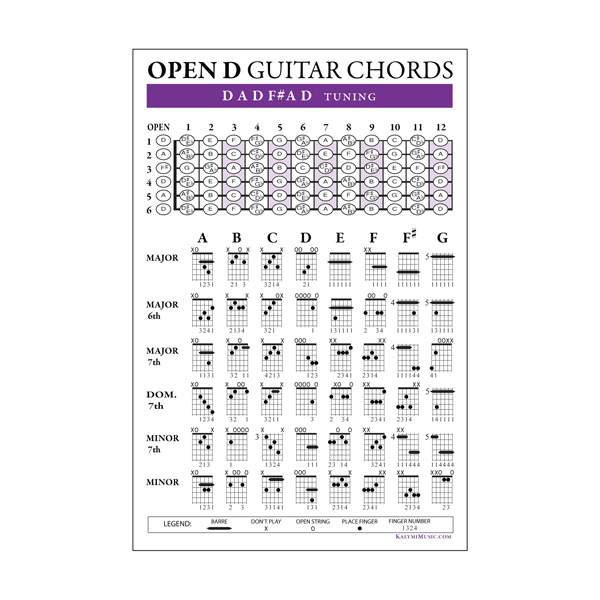Are you tired of playing the same old chords on your guitar? Do you yearn to unlock the secrets of open tunings and take your playing to the next level? Well, grab your capo and brace yourself for a wild ride, because we’re about to dive into “The Ultimate Guide to Open Tunings for Advanced Guitarists.” Get ready to channel your inner guitar god and blow minds with your newfound fretboard wizardry. Let’s rock and roll, baby!
Contents
- 1 Exploring the World of Open Tunings: An Advanced Overview
- 2 Mastering Open Tuning Transitions: From Standard to Open with Ease
- 3 Innovative Chord Shapes and Voicings in Open Tunings
- 4 Developing Advanced Techniques in Open Tuning Fingerstyle
- 5 The Role of Open Tunings in Slide Guitar Mastery
- 6 Creating Unique Sonic Landscapes with Alternate Open Tunings
- 7 Fine-tuning Your Approach: Maintenance and Setup for Open Tunings
- 8 FAQs
- 9 Time to Tune Up and Rock On!
Exploring the World of Open Tunings: An Advanced Overview
So you’ve mastered the basics of open tunings and you’re ready to take your skills to the next level. Buckle up, because we’re about to dive deeper into the world of alternative tunings that will make your guitar sound like it’s from another dimension!
One of the most common open tunings is DADGAD, but have you ever tried tuning your guitar to EBEGBE or CGDGCD? These unconventional tunings can open up a whole new world of sonic possibilities, allowing you to create rich, ethereal sounds that will make your audience do a double-take.
Experimenting with open tunings can also inspire new song ideas and help break you out of a creative rut. The unique harmonic qualities of these tunings can spark your imagination and lead to compositions that you never would have come up with in standard tuning.
So grab your guitar, experiment with some crazy tunings, and get ready to experience a whole new world of musical possibilities. Who knows, you might just stumble upon your next musical masterpiece!

Mastering Open Tuning Transitions: From Standard to Open with Ease
So you’ve spent countless hours practicing your standard tuning, feeling like a true guitar virtuoso. But now you’ve caught wind of the magical world of open tunings and you’re ready to explore. Fear not, dear friend, for open tuning transitions are easier than you think!
First things first, let’s talk about the most common open tuning out there: Open D. This tuning will turn your guitar into a beautiful, harmonious machine that’s just waiting to be unleashed. To make the transition from standard tuning to Open D a breeze, follow these simple steps:
- Tune your low E string down to a D
- Tune your A string down to a G
- Tune your high E string down to a D
Next up, let’s dive into the wonders of Open G tuning. This tuning will make your guitar sing like never before, with its bright and lively sound. To switch from standard tuning to Open G with ease, try the following:
- Tune your low E string down to a D
- Tune your A string down to a G
- Tune your high E string down to a D

Innovative Chord Shapes and Voicings in Open Tunings
If you’re tired of the same old boring chord shapes in standard tuning, it’s time to shake things up with some . Open tunings allow you to explore new sounds and create unique harmonies that will make your music stand out.
One of the coolest things about open tunings is the ability to experiment with unconventional chord shapes. From finger-twisting fretboard acrobatics to mind-bending voicings, open tunings offer endless possibilities for creative exploration.
Ready to blow some minds with your next guitar solo? Try out these unconventional chord shapes:
- The Spiderweb: Stretch your fingers across all six strings to create a web of dissonance that will leave your audience in awe.
- The Confusion: Play a cluster of notes that defy all traditional music theory rules. Who needs harmony anyways?
- The Alien Abduction: Beam up your listeners with this otherworldly chord shape that sounds like it’s straight out of a sci-fi movie.
So grab your guitar, tune it to an open tuning, and let your fingers fly across the fretboard in search of new and exciting chord shapes. Who knows, you might just stumble upon the next big breakthrough in guitar music!

Developing Advanced Techniques in Open Tuning Fingerstyle
If you’re a fingerstyle guitarist looking to take your skills to the next level, open tuning is a game-changer. But why stop at the basics when you can dive into advanced techniques that will make your playing truly stand out?
One technique that will blow your mind (and your audience’s ears) is called “harmonic cascades.” This involves playing harmonics in rapid succession to create a cascading waterfall of sound. It’s like magic for your fingers!
Another trick up your sleeve should be the use of alternate tunings beyond the standard open chords. Experiment with tunings such as DADGAD or Open D to unlock a whole new world of possibilities. Your fingers will thank you for the adventure!
And finally, don’t forget to incorporate percussive elements into your fingerstyle playing. Whether it’s slapping the strings with your thumb or tapping out a rhythm on the body of the guitar, adding some percussive flair will bring your playing to a whole new level of awesomeness.

The Role of Open Tunings in Slide Guitar Mastery
Open tunings are like the secret sauce in slide guitar playing – they add that extra flavor that truly makes your playing stand out. Instead of just sticking to standard tuning, open tunings allow you to explore new sonic possibilities and unlock the full potential of your slide guitar.
With open tunings, your slide guitar playing will sound richer, more resonant, and full of character. It’s like opening up a whole new world of musical possibilities, where every note and every slide has a unique and vibrant quality.
Mastering open tunings in slide guitar is like mastering a new language – it takes time, dedication, and a sense of adventure. But once you get the hang of it, you’ll wonder how you ever played slide guitar without open tunings in the first place!
So, the next time you pick up your slide guitar, don’t be afraid to experiment with open tunings. Let your fingers explore the fretboard in ways you never thought possible, and watch as your slide guitar playing reaches new heights of mastery and musicality.
Creating Unique Sonic Landscapes with Alternate Open Tunings
So you’re tired of playing the same ol’ boring chords on your guitar, huh? Well, my friend, it’s time to shake things up and create some truly unique sonic landscapes with alternate open tunings. Trust me, once you start experimenting with different tunings, you’ll never want to go back to standard tuning again.
With alternate open tunings, the possibilities are endless. You can create hauntingly beautiful melodies, crunchy dissonant chords, or even otherworldly harmonics that will make your listeners wonder if you’re playing a guitar or a spaceship. The key is to let your creativity run wild and explore the sounds that are waiting to be discovered.
Don’t know where to start? No problem! Here are a few alternate open tunings to get you going:
- DADGAD: This tuning is perfect for creating Celtic-inspired melodies or adding a mystical vibe to your music.
- Open D: If you’re looking for some bluesy slide guitar goodness, this tuning is your new best friend.
- DADF#AD: Want to sound like you’re playing a dozen guitars at once? Look no further than this lush and full-bodied tuning.
Fine-tuning Your Approach: Maintenance and Setup for Open Tunings
So you’ve decided to delve into the world of open tunings, huh? Well, buckle up because it’s going to be a wild ride. Before you start shredding on your guitar like Jimi Hendrix, you’ll need to fine-tune your approach with some maintenance and setup tips.
First things first, make sure your guitar is properly set up for open tunings. This means adjusting the tension on your strings and making sure your guitar neck is straight. If your guitar is looking a little wonky, take it to a professional to get it fixed up. You don’t want to be playing in an open tuning and have your strings snap on you like a bad Tinder date.
Next, it’s time to tackle maintenance. Keep your guitar in tip-top shape by regularly cleaning and oiling your fretboard. No one likes a grimy fretboard – it’s like trying to eat a sandwich with moldy bread. Also, be sure to check your tuning regularly. Open tunings can be finicky, so don’t be surprised if your guitar suddenly sounds like a dying cat after a jam session.
Lastly, don’t be afraid to experiment with different open tunings. There are countless variations out there, each with their own unique sound. Get creative and see what works best for your playing style. Who knows, you might just discover the next big thing in open tunings!
FAQs
What are some common open tunings used by advanced guitarists?
Well, advanced guitarists like to get creative with their tunings. Some popular ones include Open D (D A D F# A D), Open G (D G D G B D), and DADGAD (D A D G A D).
How can open tunings enhance my playing?
Open tunings can completely change the sound and feel of your playing. They allow you to experiment with new chord shapes, add interesting harmonics, and create unique textures in your music.
Are there any famous guitarists known for using open tunings?
Absolutely! Legends like Joni Mitchell, Keith Richards, and Jimmy Page have all dabbled in open tunings and created some iconic songs using them.
Is it difficult to switch to playing in open tunings?
It can be a bit challenging at first, especially if you’re used to standard tuning. But with practice and patience, you’ll get the hang of it and open up a whole new world of musical possibilities.
What are some resources to help me learn more about open tunings?
There are plenty of online tutorials, books, and even workshops dedicated to open tunings. You can also experiment on your own and see what kind of cool sounds you can come up with!
Time to Tune Up and Rock On!
Congratulations, advanced guitarist! You’ve now mastered the ins and outs of open tunings and are ready to take your skills to the next level. With these unique tunings under your belt, the possibilities are endless when it comes to creating new sounds and experimenting with your playing style.
So, grab your guitar, tune it up, and get ready to rock on like never before. Open yourself up to a whole new world of musical possibilities and let your creativity soar. And remember, don’t be afraid to push the boundaries and try new things – that’s where the real magic happens.
So go ahead, unleash your inner guitar virtuoso and let the world hear the incredible sounds you can create with open tunings. Rock on, advanced guitarist, rock on!



